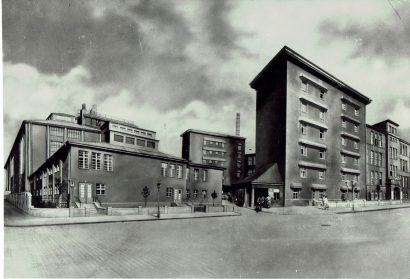THE PLACE AND ITS HISTORY
The group of buildings that house Zentralwerk is located on a plot between Großenhainer Straße, Heidestraße and Riesaer Straße in Dresden Pieschen, and looks back on a history full of changes.
In the early 1920s, the first production building on site was erected by Clemens Müller AG. Until its closedown, the factory produced sewing machines and industrial type-writers.
From 1939 on, the site was reconstructed with money coming from the treasury of the German Reich to serve the armaments industry, based on a secret contract with the supreme command of the German navy. The production facility owned by the German Reich was given to Zeiss Ikon AG for use and became known as “Goehle-Werk”.
On order of the German Reich navy, Zeiss Ikon AG produced mainly anti-aircraft gun ignitors, but also ignitors for depth charges and detonating fuzes for shrapnel shells. Zeiss Ikon’s Dresden factories were the biggest producer of armaments in the city during WW II, employing about 6,000 workers.
The skilled workers needed for fuze production (toolmakers, watchmakers and precision mechanics) were initially conscripted to work at Goehle-Werk by the employment agency. Over the course of the war, more and more forced laborers were recruited, beginning with about 300 Jews from Dresden.
In 1944/45, Zeiss Ikon employed at least another 2,600 forced laborers and more than 1,000 concentration camp detainees.
Between October 1944 and April 1945, a total of 700 women from the concentration camps Flossenbürg (200 women), Auschwitz (300) and Ravensbrück worked at Goehle-Werk. The inmate workers from Flossenbürg and Auschwitz were almost exclusively from Russia and Poland. The last shipment from Ravensbrück counted women from Russia and Poland as well as many Germans and French and some women from Luxembourg, Italy, Czechoslovakia and one Egyptian.
The women lived in the building, their working places were located two or three floors below.

 During the so-called Goehle-Werk trials in January 1949, ten defendants, among them the deputy factory manager Nitsche, several foremen and female SS guards, were convicted to prison sentences between one and eight years.
During the so-called Goehle-Werk trials in January 1949, ten defendants, among them the deputy factory manager Nitsche, several foremen and female SS guards, were convicted to prison sentences between one and eight years.After 1945, the production building was converted into the printing house Grafische Großbetriebe Völkerfreundschaft (friendship between nations). The entire range of socialist printed material was printed here, from the GDR children’s magazine Frösi to internal party printed matters. The Karl Herrmann hall, today’s ballroom, was one of only a few – and supposedly the most important – place for culture in the destroyed city of Dresden after World War II.
The site was abandoned in 1997 and, apart from some temporary tenants in the ballroom, no longer in use. The history of this rather striking building complex fell more and more into oblivion. While many people from Dresden still remembered it as a printing house, its history until 1945 was mostly forgotten.
In 2015, the place was converted into a cultural factory. Initiated by friedrichstadtZentral e.V. (now Zentralwerk e.V.), the Zentralwerk Culture and Housing cooperative was founded. Zentralwerk combines living and working, art and culture in one place. Artists, researchers, architects and craftspersons meet in an environment characterized by intersections. Various disciplines and people of all ages create a common space; exchange, heterogeneity and collaboration is their daily business. In this way, Zentralwerk creates an ongoing and lively discourse that goes beyond the limits of its grounds thanks to the open cultural and artistic activities in the ballroom.
